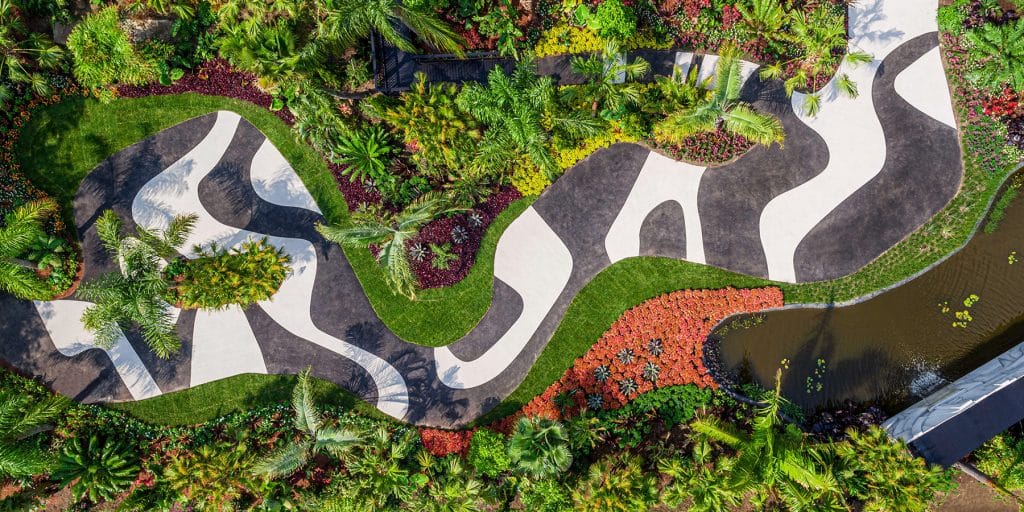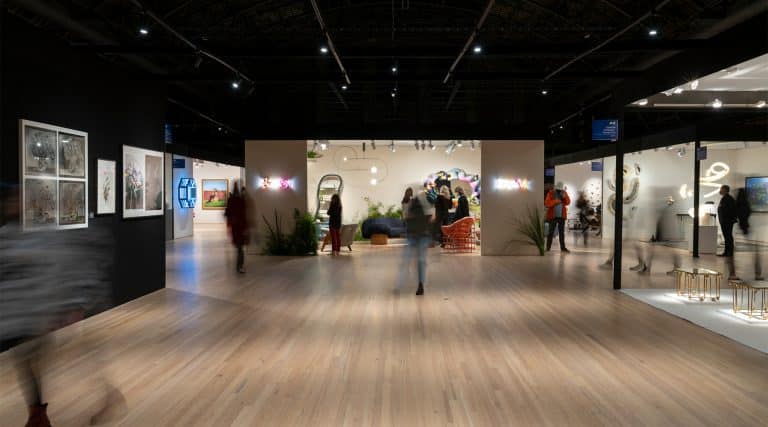
June 23, 2019The subject of a show at the New York Botanical Garden (NYBG) on now through September 29, Brazilian modern landscape architect and artist Roberto Burle Marx was also a plant explorer and conservationist. This picture was taken on a 1974 botanical expedition in Ecuador (photo by Luiz Knud Correia de Araújo, archive of Luiz Antonio Correia de Araújo). Top: NYBG’s exhibition includes a new Burle Marx–inspired garden created by Raymond Jungles, a contemporary acolyte of the 20th-century master.
You could be forgiven for not knowing that the man with the wide disarming grin and horn-rimmed glasses a little askew, almost entirely covered by a gargantuan elephant’s ear leaf, is Roberto Burle Marx, the celebrated Brazilian modern landscape architect. Captured in a quasi-candid photograph on a botanical expedition to Ecuador in 1974, he is clearly very much enjoying himself. And from now through September 29, if you make your own expedition to the New York Botanical Garden (NYBG), in the Bronx, you, too, will very much enjoy yourself. For there, you will find this rumpled-looking man serving as centerpiece of a spectacular new show — and you’ll discover why Burle Marx, although still too little known in this country, is a beloved and revered Brazilian cultural icon.
For many years, NYBG has taken a multidisciplinary approach to its summer shows. Whether featuring a particular artist, such as Frida Kahlo, Georgia O’Keeffe or Dale Chihuly; focusing on a group of artists; or examining the life and work of the scientist and plant explorer Charles Darwin, each show has linked horticulture to a guest-curated exhibit. The intention is to make manifest the relationship between botanical matters and the visual arts and to challenge us to better appreciate and understand this connection. That objective has been beautifully realized in this year’s phenomenal show, “Brazilian Modern: The Living Art of Roberto Burle Marx.”
In addition to designing almost 3,000 innovative landscape projects — mostly in Brazil and Venezuela but also throughout the American continent —Burle Marx (1909–94) was also a plant explorer and passionate advocate for the preservation of the native Brazilian biota. Beyond that, he was a highly accomplished painter; sculptor; graphic artist; and designer of tapestries, of costumes for ballet and opera and of jewelry. (To mark the opening of the NYBG show, Mahnaz Collection mounted an exhibit of sculptural modernist gems made by Burle Marx and by his brother, Haroldo, in the 1960s.) The consummate polymath was equally at home in all these different fields, moving effortlessly between them. In his oeuvre, it’s hard to know where one form of art left off and another started, although he noted, “Each specialty calls for is own technique and medium of expression.”

Burle Marx’s estate outside Rio de Janeiro served as a living laboratory for his various vocations, with studios for painting and drawing and a fantastic garden of his own design planted with native flora. It is now open to the public. Photo by Livia Comandini / Getty Images
Certainly, there is an unmistakable affinity between his art and his boldly modern landscape creations, characterized by the use of native plants, rich tonal colors and sensual biomorphic shapes. As he once explained in an interview: “It is not only as a botanist or garden designer that I think about gardens. I was trained as a painter. . . . The problems of harmony and contrast of colors, structure and form are as important for me as a two-dimensional painter as they are in gardens of three and even four dimensions. My two professions complement each other.”

This 1983 gouache on paper represents Burle Marx’s plan for a rooftop garden at the headquarters of Banco Safra, in São Paulo.
Burle Marx’s gardens ranged from private commissions to major public projects. The latter began with the design of plazas for Recife, in northeast Brazil; in the 1930s came a series of major gardens in Rio de Janeiro, where he started working closely with Oscar Niemeyer and changed the face of large swaths of the city. Later, in the 1960s, he worked on the new Brazilian capital, Brasilia, continuing his close collaboration with Neimeyer, whose master plan and monumental buildings define the government center. He also undertook international projects as far afield as Paris and Kuala Lumpur, Malaysia. His own estate outside Rio, which he purchased in 1949, became the nexus for all his artistic and botanical activities. Here, he restored buildings, created two studios for painting and drawing and planted a magical garden. Now open to the public, the estate harbors an extraordinary collection of Brazilian native plants, many of which Burle Marx rescued from near extinction during his numerous plant-gathering trips. He loved to bring friends and colleagues — who included architects, painters, scientists, poets and musicians — here, to his home, studio, garden and plant nursery. Burle Marx’s parties were renowned: A musician on top of his other accomplishments, he would entertain guests by singing old Brazilian songs or, more often, German lieder. (His father was born in Stuttgart.)

In addition to the outdoor Modernist Garden by Jungles, the Burle Marx show at the NYBG includes, inside the Enid A. Haupt Conservatory, an Explorer’s Garden, devoted to the tropical rainforest plants that Burle Marx preferred. Courtesy of NYBG
For its exhibition, NYBG invited contemporary landscape architect Raymond Jungles, a protégé and close friend of Burle Marx’s, to create an outdoor garden that would bring alive the Brazilian master’s design approach and demonstrate his aesthetic. “It’s a temporary garden, but I am using circulation, pavement and vistas in ways I could see Roberto using them, and using plants in the way I actually saw Roberto use them, for emphasis,” says Jungles. “It is all meant to evoke his spirit.”
And it does.

Here, in an image from the 1980s, Burle Marx works on a painting in his home studio. His artistic endeavors were always aligned, in one way or another, with his horticultural ones. Photo by Ayrton Camargo / Tyba
Jungles and NYBG have pulled off an amazing feat — all the more so given the added challenge of being entirely out of doors rather than safely cocooned within the protective glass walls of the Enid A. Haupt Conservatory (whose dome is now undergoing restoration). Jungles’s “Modernist Garden” is made up of a series of curved undulating planting beds that surround sinuously patterned wave-shaped black pathways. These converge on an open plaza dominated by a large pool, behind which water falls through an opening in a towering wall — a scaled-down interpretation of a relief mural that Burle Marx created in 1983 for the interior of the Banco Safra headquarters in São Paulo.
The plant palette showcases the beauty and diversity of Brazilian flora: Dramatic sweeps of bromeliads, philodendrons, elephant’s ears, mealycup sages, glory-bushes and coleuses are brilliantly paired in strikingly unusual combinations and punctuated with almost 100 mature palm specimens, primarily Brazilian and Caribbean natives. Most of the palms, cycads and large plants were brought in from Florida, but the herbaceous plants, more than 3,000 of them, were entirely grown in the greenhouses at NYBG. Jungles has artfully integrated all of them into his design, creating a garden that is at once bold, colorful, sophisticated and alluring.

This untitled 1968 Burle Marx work, in acrylic and industrial dye on fabric, almost looks like a plan for one of his landscapes. Photo by Jacek Gancarz
Jungles’s creation serves as the focal point, but the show also includes two other landscapes: An Explorer’s Garden — in a small interior exhibition space inside a still-open portion of the Haupt conservatory — highlights many of the tropical rainforest plants that Burle Marx liked to use, and a Water Garden, in the large pool behind the conservatory, presents a collection of tropical water lilies and other aquatic flora.
Inside the LuEster T. Mertz Library’s gallery, meanwhile, guest curator Edward J. Sullivan, deputy director of NYU’s Institute of Fine Arts, has put together a compelling exhibition of Burle Marx’s paintings, drawing and textiles dating from the 1960s on. Here, vibrant abstract oils and acrylics — some painted on linen, others on canvas — flank a huge, abstract wool and cotton tapestry woven by artisans in Brazil in 1971 and lent by the Art Institute of Chicago. Elsewhere, two lithographs, both executed in 1991 as part of a series depicting the mangrove forests of Brazil, show the figurative side of Burle Marx’s work, while an earlier gouache exemplifies the range of media he used.
(New York’s R & Company boasts its own collection of important Burle Marx textiles and prints, in addition to drawings that served as sketches for garden ideas. These further illustrate the unique dialogue between his garden designs and his artworks, as well as the influence of abstract and Brazilian folk art on his oeuvre. Many of the pieces are now on view in a just-opened show at the 1stdibs Gallery, in West Cheslea, alongside ones by contemporary Brazilian furniture designer Hugo França.)

“It’s a temporary garden,” Jungles says of his landscape at NYBG. “But I am using circulation, pavement and vistas in ways I could see Roberto using them, and using plants in the way I actually saw Roberto use them, for emphasis. It is all meant to evoke his spirit.” Courtesy of NYBG
The works exhibited at NYBG confirm Burle Marx’s status as a significant artist, and the synergy between his art and his gardens makes this an illuminating show not to be missed. One comes away from the NYBG display with newfound admiration for this multitalented, exuberant genius, whose achievements, both in horticulture and in the wide variety of other media he employed, draw on his deep connection to nature and reinforce the idea that he knew how to enjoy life to the fullest.


